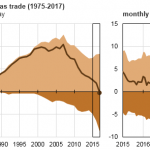
Last week the EIA reported that China will become the second largest LNG importer in the world, behind Japan. Several outlets have written about this growth and what it means to the industry as a whole.
The report states that China surpassed South Korea to become the world’s second-largest importer of liquefied natural gas (LNG) in 2017, according to data from IHS Markit and official Chinese government statistics. Chinese imports of LNG averaged 5 billion cubic feet per day (Bcf/d) in 2017, exceeded only by Japanese imports of 11 Bcf/d. Imports of LNG by China, driven by government policies designed to reduce air pollution, increased by 1.6 Bcf/d (46%) in 2017, with monthly imports reaching 7.8 Bcf/d in December.
China’s imports of natural gas have grown to meet increasing domestic natural gas consumption, which has been primarily driven by environmental policies to transition away from coal-fired electricity generation. The Chinese government has also implemented policies to convert several million residential households in China’s northern provinces, which traditionally rely on coal heating in the winter, to use natural gas-fired boilers instead.
With the continued growth of China, it’s only a matter of time (albeit a while) before they take over Japan in the number one spot.






























